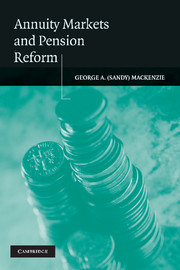Book contents
- Frontmatter
- Contents
- List of Tables
- Acknowledgments
- Introduction
- PART ONE
- PART TWO
- 5 Individual Liberty versus Security in Retirement, and the Government's Role
- 6 Policy Issues with Both Public and Private Sector Provision of Mandatory Annuities
- 7 Policy Issues with Privatization of the Provision of Annuities
- 8 Conclusions and Recommendations
- Appendix 1 The Economics and Financing of Annuities
- Appendix 2 Aging and Its Impact on Pension Systems
- Glosssary
- References
- Index
6 - Policy Issues with Both Public and Private Sector Provision of Mandatory Annuities
Published online by Cambridge University Press: 13 November 2009
- Frontmatter
- Contents
- List of Tables
- Acknowledgments
- Introduction
- PART ONE
- PART TWO
- 5 Individual Liberty versus Security in Retirement, and the Government's Role
- 6 Policy Issues with Both Public and Private Sector Provision of Mandatory Annuities
- 7 Policy Issues with Privatization of the Provision of Annuities
- 8 Conclusions and Recommendations
- Appendix 1 The Economics and Financing of Annuities
- Appendix 2 Aging and Its Impact on Pension Systems
- Glosssary
- References
- Index
Summary
INTRODUCTION
This chapter begins by elaborating on the general arguments that Chapter 5 advances as to why general rules, and not individual preferences should govern the extent of annuitization of account balances, and considers what form distributions should take. It then turns to address various issues that mandatory annuitization entails for the safety net. These include the merits of a guarantee on annuity balances, the distributional effects of a carve-out reform, and the implications of reform for family benefits and the disability pension. This chapter also briefly discusses some legal issues that arise with the creation of individual accounts, since they have a bearing on family benefits. This chapter concentrates on those issues that could arise with mandatory annuitization regardless which sector provides the annuities. Chapter 7 addresses the additional issues that private provision entails.
THE SCOPE FOR RESPECTING INDIVIDUAL PREFERENCES
Most people could benefit from the annuitization of at least part of their wealth when they retire. The question is how much. The case for annuitization is the strongest for people who either have little annuitized wealth to begin with, or would have problems managing their expenditure without the discipline that annuitization provides. As Chapter 5 argued, the case is weak for an account holder whose wealth is already highly annuitized. It is also weak for some one who is relatively well off and able to manage a budget.
- Type
- Chapter
- Information
- Annuity Markets and Pension Reform , pp. 144 - 162Publisher: Cambridge University PressPrint publication year: 2006



